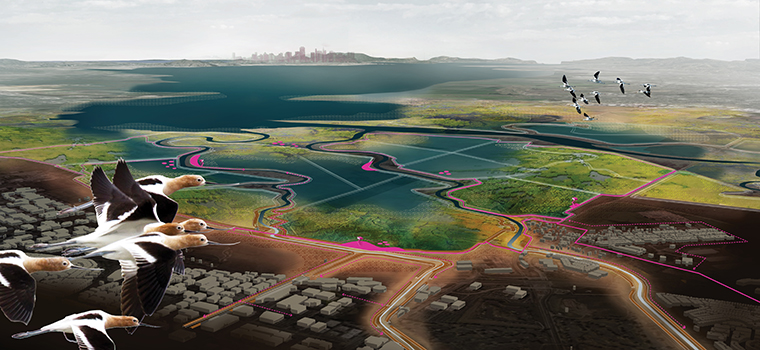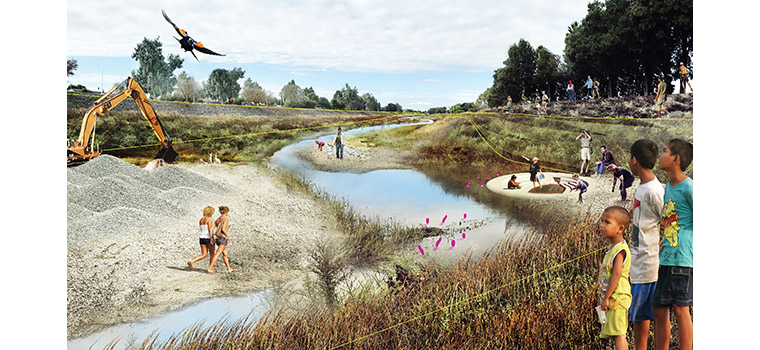Six months ago, local leaders concerned about the impact of climate change on the Bay Area's waterfront communities kicked off the Resilient by Design Bay Area Challenge and asked architects, engineers and designers to come up with innovative ideas for mitigating the effects of global warming on 10 Bay Area sites identified as being at risk.

Public Sediment, a team made up of environmentally minded architects, designers, experts and researchers, proposes enabling more sediment to reach the San Francisco Bay via Alameda Creek in order to build up protection against rising sea levels that threaten waterfront areas.
BY BILL PICTURE
Published: February, 2018
Six months ago, local leaders concerned about the impact of climate change on the Bay Area’s waterfront communities kicked off the Resilient by Design Bay Area Challenge and asked architects, engineers and designers to come up with innovative ideas for mitigating the effects of global warming on 10 Bay Area sites identified as being at risk.
Of the 51 submissions received, 10 were selected to move from the preliminary research phase into the design phase. Among those 10 was an idea to enable more sediment to reach the San Francisco Bay via Alameda Creek in order to build up protection against rising sea levels that threaten waterfront areas. That proposal was the brainchild of Public Sediment, a “multidisciplinary resilience team” made up of environmentally minded architects, designers, experts and researchers.
“Undoing a mistake that humans have made is sort of a common thread in environmental engineering,” said Chris Devick, coastal water engineer for Arcadis, a member of the Public Sediment team. “What we try to do is learn from those mistakes made in the past to hopefully make for a better future.”
Man vs. nature
Sediment once flowed freely down the waterways that connect to the San Francisco Bay, replenishing marshes and mudflats that tides chip away over time. These marshes and mudflats are the first line of defense against encroaching seawater for shoreline neighborhoods, but they are shrinking because most of the sediment is now trapped by the dams and channels built upstream over the last 150 years. Shoreline neighborhoods are therefore increasingly vulnerable to floods and severe storms.
“Mud has historically been considered more of a nuisance than anything else,” Devick said. “But it’s really a very important piece of flood protection. We know that now, so part of what we’re thinking about is, ‘How do we get people to recognize mud as a public resource?’”
Changing people’s relationship with mud shouldn’t be too hard, according to Devick. “I think people understand the threat posed by climate change and the important role that marshes and mudflats play,” he said. “And with the right engagement and interaction, I think people will easily revert to their childhood and want to stomp around in the mud.”
Devick said that outreach and education will likely be a key part of the proposal submitted at the end of the design phase by Public Sediment, whose members also include SCAPE Landscape Architecture, Dredge Research Collaborative, TS Studio, the UC Davis Department of Human Ecology and Design, the UC Davis Center for Watershed Sciences and Buoyant Ecologies Lab.
“Buy-in at all levels—from regulators and local government, to the general public—is crucial,” Devick said.
The 10 teams selected to participate in the design phase are expected to submit their final proposals by mid-May. Just two weeks into the current phase, Devick says Public Sediment’s members have already brought some great ideas to the table. Among their strategies is retrofitting dams to better facilitate the natural flow of sediment, unlocking tributary channels, and testing new methods of mud placement in the Bay.
Alameda Creek v2.0
The Alameda Creek that Public Sediment envisions for future generations looks much different than today’s. Steelhead trout would be reconnected with their natural spawning grounds upstream. Meanwhile, a network of creek-side paths would link communities of various races, ethnicities and income levels with each other and the Bay. Young people from those communities would be enlisted to monitor sediment flow. The result would be a waterway reimagined for better protection of the Bay, for social equity and for preservation of Bay-native species.
The next step for Public Sediment’s members is gauging the feasibility of their ideas. “This phase is about refining,“ said Devick. “We have to examine each design opportunity in much greater detail and ask ourselves, ‘Is this really implementable?’”
Part of the design process is talking with regulatory bodies—public and private—to understand current legislation and regulatory requirements, and ensure that the ideas presented in May can clear existing legal hurdles. “We’ve received some very encouraging comments from those bodies regarding the ideas that we’re moving forward with,” Devick said.
Devick hopes that the ideas presented by the 10 teams in May will help shape future legislation. “I think the hope with much of the Resilient by Design process is to start some conversations,” he said. “Locally, several agencies are already in the process of reevaluating their own requirements in light of climate change and sea level rise.”
“In terms of our project, a lot of these agencies understand how important sediment is to wetlands and the Bay. So I think we’re in a good spot to have a production conversation about how projects can be authorized.”
Identifying a project partner that can provide funding to realize a team’s ideas is also a part of the design process. “The end goal is to find a project with a clear, implementable path forward,” Devick said. “That means having an identified way for regulatory approval and funding.”
Bay Area Resilient by Design was inspired by a similar design competition launched after Hurricane Sandy devastated communities in New York, New Jersey and Connecticut in 2012. President Obama’s Hurricane Sandy Rebuilding Task Force launched Rebuild by Design to come up with implementable regional and replicable solutions to future climate emergencies.
Nearly 150 applicants from all over the world submitted proposals, and 10 teams were selected to further develop their ideas. Of the 10 final proposals submitted, seven are currently being implemented throughout the Northeast.
Arcadis was among the teams that participated in New York’s Rebuild by Design. “Bay Area Resilient by Design is different,” Devick explained. “We saw what can happen, we know that climate change is happening, and we’re being proactive.”
Devick concedes that devising a strategy to address sea level rise and identifying a partner who’s willing and has the means to see it through is a tall order. Still, he’s confident that it’s doable. “We stay positive because we know it’s possible,” he said. “It’s challenging, but we can do this!”
Images courtesy of Public Sediment.
For more information about Resilient by Design and the Bay Area Challenge, visit www.resilientbayarea.org.

The Alameda Creek that Public Sediment envisions for future generations looks much different than today’s.

